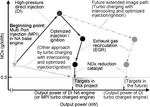Japanese team developing direct-injection hydrogen internal combustion engine for heavy-duty trucks
5 November 2010

|
| Strategy for approaching current and future performance targets. Source: Kawamura et al 2010-01-2175. Click to enlarge. |
Researchers from Tokyo City University and the National Traffic Safety and Environment Lab in Japan are developing a multi-cylinder direct-injection spark-ignition (DISI) hydrogen internal combustion engine (ICE) for application in heavy-duty vehicles. The project aims to deliver a hydrogen ICE system combining high power output and low NOx generation.
The research team published a paper on their efforts in conjunction with the recent SAE Powertrains Fuels & Lubricants meeting, but without an oral presentation at the conference. Separately, Tokyo City University, in cooperation with Hino, unveiled a hydrogen-powered truck offering roughly the same performance level as a diesel-engine hybrid model. The university said it will seek to commercialize the vehicle.
For small- and medium-sized trucks, diesel hybrid systems can be put into practical use. However, a battery or a hydrogen FC cannot be used in large-sized (heavy duty) trucks, which currently require a high power output. For the aforementioned reasons, the hydrogen ICE system development project for heavy-duty vehicles is promoted by the Next-generation Environmentally Friendly Vehicle Development and Commercialization Project (EFV21) of the Ministry of Land, Infrastructure, and Transport (MLIT) of Japan as one of the technical candidates that can greatly reduce the air pollution and global warming contribution of such trucks.
—Kawamura et al.

|
| Engine performance curves showing hydrogen DISI ICE and the base diesel. Kawamura et al. Click to enlarge. |
The target hydrogen ICE was based on a Hino J05D-TC diesel engine. The naturally aspirated 4.7L engine is equipped with spark ignition and water-cooled EGR, and operates at a compression ratio of 12.7:1. Turbocharging with intercooling and optimized injection/ignition will be applied in a subsequent phase of the project.
The core technologies in development for the DISI multi-cylinder hydrogen ICE system include:
- a high-pressure hydrogen gas direct injector;
- a combustion control strategy for the DISI hydrogen ICE; and
- a NOx reduction catalyst system.
Injector. The team developed a high-pressure hydrogen gas direct injector based on a common-rail type direct injector for the base diesel engine, thus maintaining installation compatibility. The injector is compact, and is able to instantaneously inject a large quantity of hydrogen into the high-pressure combustion chamber.
Hydrogen gas is supplied at a maximum pressure of 20 MPa (200 bar) to maintain its independence from the flow of the working fluid—currently diesel fuel, but to be a non-fuel fluid in the future. The opening and closing of the needle valve are performed by controlling the spill amount of the working fluid supplied from a common rail by the timing of an electromagnetic valve. The injector aims to achieve the high-speed response needed for multiple-stage injection in the future.
Combustion control strategy. To reduce engine-out NOx, the team developed a combustion control strategy that maintained the air/fuel ratio (lambda) at more than 2 during low-load condition and at approximately 1 during medium- and high-load conditions.
NOx reduction. The team combined a NOx Storage Reduction (NSR) catalyst and Oxidation Catalyst (DOC) as an exhaust aftertreatment system to further reduce NOx. The NSR catalyst has a characteristic that stores NOx in lambda > 1; the DOC was added in order to purify the unburned hydrogen from the hydrogen ICE or from the reducing agent.
Results. Under limited driving conditions (engine speed 1,000 rpm, with EGR, NA), the developed combustion control strategy returned low NOx emissions (0.7 g/kWh), high power output (IMEP 0.85 MPa), and high indicated thermal efficiency (41%).
The engine delivered the target power output of 100 kW, and showed emissions to the levels below those specified in the Japan 2009 regulations.
For further performance enhancement of the DISI multicylinder hydrogen ICE system, improved stability and durability of the high-pressure hydrogen gas direct injector and optimization of the transient control system will be necessary. Mileage evaluation of the DISI hydrogen ICE will require the development of a method for high-pressure hydrogen consumption measurement at transient operation.
In addition, with respect to unregulated substances such as N2O in the NSR catalyst, it will be necessary to devise a combustion strategy such as moderate injection and/or ignition near the TDC that enables further NOx reduction at the engine outlet and expanded coverage. In these efforts, it will be necessary to perform the visualization and the CFD simulation of high-pressure hydrogen injection/mixture formation. These are in progress now partly in the next efforts of this project. And the development of an in-vehicle hydrogen tank system will also be necessary for realizing trucks using the DISI multi-cylinder hydrogen ICE system.
—Kawamura et al.
Resources
-
Atsuhiro Kawamura, Yoshio Sato, Kaname Naganuma, Kimitaka Yamane and Yasuo Takagi (2010) Development Project of a Multi-cylinder DISI Hydrogen ICE System for Heavy Duty Vehicles (SAE 2010-01-2175)
-
Green Car Congress © 2010 BioAge Group, LLC. All Rights Reserved. To subscribe or visit go to: http://www.greencarcongress.com